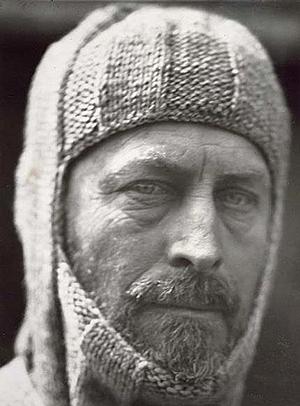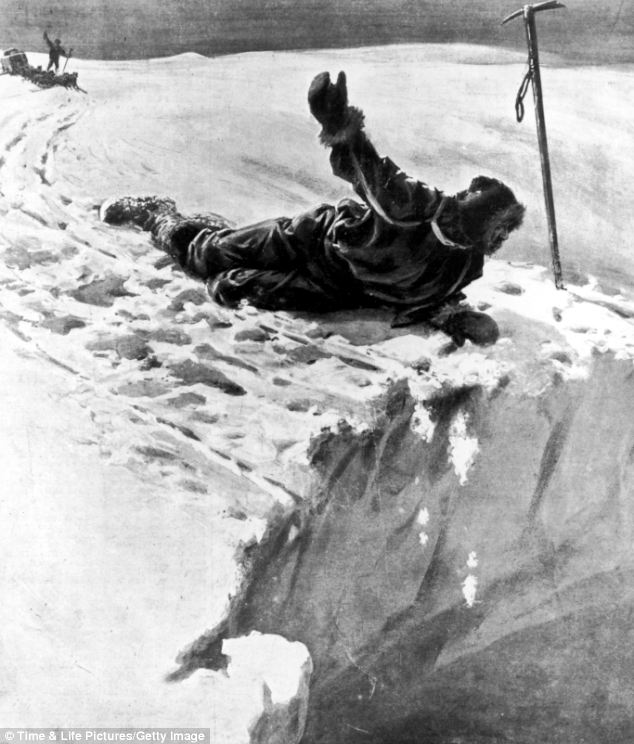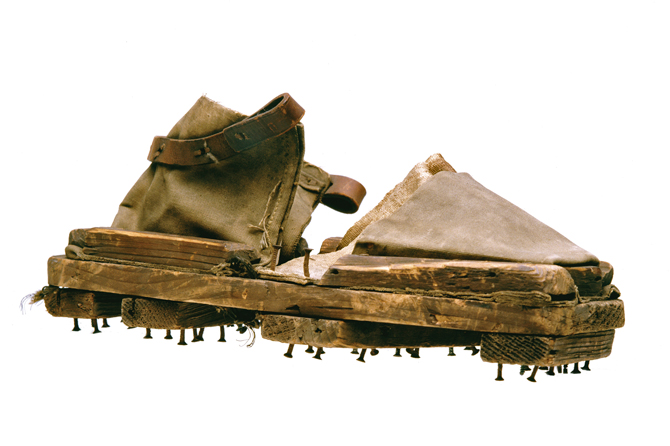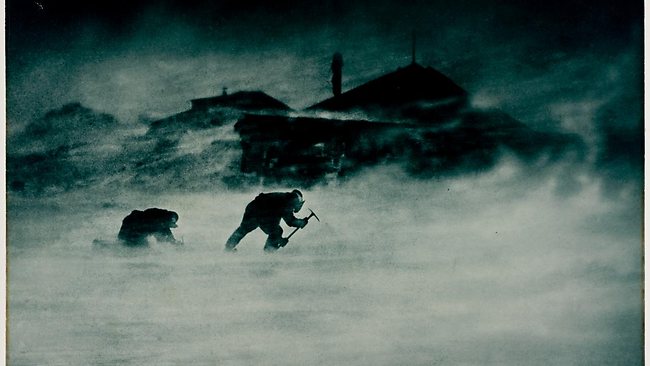At the beginning of the twentieth century, the Antarctic continent was still largely unexplored. Vast expanses of its terrain remained terra incognita. The task of turning the incognita to the cognita fell on the shoulders of intrepid men who were willing to assume the hardships and risks of the continent’s unforgiving landscape. Thirty-year-old Australian geologist Douglas Mawson was one such man. Already having some acquaintance with polar exploration by 1910, he organized what came to be called the Australasian Antarctic Expedition in that year. Its mission would be to explore and collect data on King George V Land and Adelie Land, two portions of Antarctica about which very little was then known.
Douglas Mawson as expedition commander. The face of a man who could not be broken.
The expedition landed in Antarctica in early 1912 and proceeded to set up its main base on Commonwealth Bay. Mawson’s plan called for several different sledging parties—31 men in all—to explore different regions and collect data along the way. He himself was a meticulous and exhaustive planner, unwilling to leave even the slightest details to chance. With two companions, Xavier Mertz and Belgrave Ninnis, Mawson set out to penetrate the interior of King George V Land and conduct surveys there. The goal would be to collect as much data as possible about the geology, climate, glaciology, and magnetism of the vast 2,000-mile-long tract of unknown land.
The harshness of the environment in which the men found themselves can scarcely be exaggerated. Besides the subzero temperatures, winds regularly exceeded 200 miles per hour; it was later found to be the windiest place on earth. Even worse, the snow and ice over which they traversed concealed deep fissures covered by snow bridges. These crevasses were deathtraps which could elude even the most experienced eye. At any time, a man might find himself plunging through the snow to an icy death hundreds of feet below, swallowed up by an icy abyss. Sophisticated cold-weather and mountaineering equipment would not be invented for decades; the only protection was for the men was to tether their bodies to the sledges and hope that a crevasse fall would not pull everything down together with it.
While crossing the Ninnis Glacier about 500 kilometers from the main base, Mawson’s party was stricken with calamity. Twenty-five-year-old Belgrave Ninnis and his sledge—carrying nearly all of the food, the tent, critical supplies, and the best sled dogs—hurtled into a crevasse. Peering into the depths of the fissure while lying on their stomachs, a horrified Mawson and Mertz could see two dogs, one dead and a second dying, on an ice shelf one hundred and fifty feet below; of Ninnis and his sledge there was not a trace. The full horror of the situation now descended on Mawson. They were nearly 310 miles from the main base, with almost no food and nothing substantial to use as shelter. They improvised a tent that night from a piece of canvas and two of Mertz’s skis, laying their reindeer-hide sleeping bag directly on the snow.
Ninnis’s fall into a crevasse set the stage for a battle for survival
There now ensued a grim battle for survival which has no equal in the annals of exploration. For navigation the men possessed only a battered theodolite. With no food for the dogs, and only a tiny amount of dried meat, biscuits, raisins, and cocoa, the plan was to eat the sled dogs as they went, feeding their bones and hides to the other dogs. It was a ghastly programme, but one imposed by necessity. Over huge snowdrifts, treacherous ice, and perilous crevasses, the two men hauled their sledge with steadily-ebbing strength. They threw away everything that was not absolutely necessary, including the precious camera and film that had documented the expedition. Only one of the dogs was strong enough to haul, and he was slowly wasting away from starvation and exposure. With every passing day, the race against Death grew more uncertain.
Mertz began to fail. Starvation, physical dysfunction, and despair had taken hold, and he was unable to maintain a steady pace. Slowly his mind began to crumble; a combination of polar depression and nutrient deficiency, exacerbated by hypothermia and overexertion, had broken his spirit. Mawson saw him actually bite off the top of one of his frostbitten fingers. Yet he refused to abandon his companion. He nursed Mertz the best he could, even helping him attend to his most intimate bodily functions and then cleaning him afterwards. That was the kind of man Mawson was. But he knew the end was fast approaching; one night Mertz began to succumb to fits of delirium in which Mawson had to physically restrain him. He died in agony soon after.
Without a miracle, Mawson would soon be joining him in death. The quantity of his food supply had dwindled to just a few miserable handfuls. His flesh was beginning to fall off his bones, a consequence of the extreme cold and starvation; his hands and face were frozen lumps. Most serious of all, the soles of his feet actually detached from his body, oozing puss and blood. He had to bind them up as best he could, and put on six pairs of socks to hold his flesh together. And there was still over one hundred miles left to go. But he refused to lie down and die. “I shall do my utmost to the last,” he scribbled in his diary.
He stripped the sledge and the wooden theodolite case with his knife, and fashioned crude crampons by forcing screws and nails through pieces of wood. These he lashed to his feet. Without such preparations, he would not be able to cross the ice formations that blocked his way to the hut. The sledge was sawn in half, a truncated instrument he dragged for the remainder of the journey.
Mawson’s handmade “crampons” which he pieced together
About 80 miles from the hut, he was now walking, stumbling, and crawling through the freezing crevasse-laced landscape. There were so many snow drifts and ice sheets that he could make little progress on some days. Mawson saved his life by the slenderest of threads one day when he broke through a snow bridge and plunged into a crevasse. The sledge he was tethered to held him fast, but he was dangling by a 14-foot rope in free space. Below him was an infinity of darkness. He hung there for a time in despair, wondering if he should slip himself out of his harness and fall into the abyss below.
But he slowly recovered himself. Luckily Mawson—ever the meticulous planner–had taken the precaution of knotting the rope at regular intervals for just such an eventuality. This fact now saved his life. Slowly, and despite his weakened condition, he pulled himself hand-over-hand out of the crevasse, assisted by the knots in the rope. But as he tried to haul himself completely out, the crevasse lip broke away and he fell back in again. This was the closest he ever came to utter despair. He barely had strength to pull himself up once. How could he do it again? But then, while twisting in the emptiness of the black void, some lines of poetry came to his mind. And this was what kept him out of the abyss. He repeated this refrain from his favorite poet, Robert Service:
Just have one more try—it’s dead easy to die
It’s the keeping-on-living that’s hard.
His reading was his salvation. Summoning all his last reserves of strength, and willing power into his ravaged, emaciated frame, he pulled himself up, up and finally out of the abyss. Rolling away from the lip of the crevasse, he fainted. He awoke hours later, covered in snow. (David Roberts, author of Alone On The Ice, the definitive account of Dawson’s ordeal, notes that in 2007 experienced polar explorer Tim Jarvis tried to duplicate Mawson’s rope climb. He was unable to).
Mawson knew that the time for the final push had come. Death was closing in on him and he was beginning to lose control of his motor skills. He was by now long overdue at the hut. There was no way of knowing whether his other expedition teammates had given him up for lost, and left with the ship Aurora that was scheduled to carry them back to Australia. Mawson forced his broken body forward, one foot in front of the other, each step a symphony of agony. The winds were so strong that often he was lifted off his feet and tossed about in the snow and ice. Some of his progress was made on his hands and knees. When he was about 28 miles from the hut, he discovered a stash of food and a note left by his comrades, who had placed it there in case he returned. Mawson took ten days to cover that last 28 miles. He simply refused to die.
As he approached Commonwealth Bay, Mawson made out a black speck in the distance. He approached it, walking, stumbling, and crawling, and he could eventually see that it was the hut. One of the remaining search party, a man named Frank Bickerton, chanced to see Mawson lurching about in the distance in the snow. He and several other men ran out to make contact with the desperate figure. They did not know who he was at first. The skin was falling off what remained of his flesh, most of his hair had fallen out, his hands and feet were barely functional, he was covered in frostbite and frozen sores, and he could hardly speak. Mawson collapsed in their arms, and his ordeal was over.
It was the greatest single feat in the history of polar exploration. He had had no assistance, little food and shelter, and only the most rudimentary equipment and navigational tools. His odyssey had covered 310 bitter miles. On his return to Australia in 1914, Mawson was knighted by King George V; never was the honor so well deserved. He wrote an engaging account of his experiences entitled The Home of the Blizzard, and occupied the remainder of his life in geologic study.
He had gone toe-to-toe with the Universe, and he had won.
Read More: Ascent Into Eternity: The Unconquerable Will Of George Mallory




These days a person in that situation would tweet about it while dangling from the rope and start a hashtag campaign against misogyny and racism claiming that the crevasses are a product of patriarchy and anybody not commiserating with it is a racistsbigothomophobe who sides with the unfair status quo of the Antarctic.
It still would not have ended well.
You made me laugh, man. Well done.
“These days a person in that situation would tweet about it while dangling from the rope and start a hashtag campaign against misogyny and racism claiming that the crevasses are a product of patriarchy and..”
Damned straight.
Gone are the days of men with testicles and courage. Don’t expect this kind of amazing feat from any guy of today’s “Generation Buttplug” .
Challenge accepted – generation buttgrab
dilation of the rectum can be a useful skill, especially for a DJ or Movie Producer…. how else do you think they get funding and contracts signed ?
Good point. I stand corrected.
See, feminists wouldn’t dare to complain about a non-white male eve if he were to evil, but they bash and mock whites as if they’re enemy. If a white woman were to say today: ‘I only date white men, my preference’..she would be called out..actually not even, if she were to state ‘Nothing against other races, but I prefer white men’ she would still get hate from sjw and feminists, they’re that extreme and intolerant.
In order to ignore the pest, when I detect ‘white privilege’ being mentioned in someone’s post on tumblr, I exit the page, they’re incredibly toxic.
Guys in California….careful – this rape bill is completely written against us http://www.washingtontimes.com/news/2014/sep/29/california-gov-brown-signs-yes-means-yes-rape-shie/
Here’s the article on D&P explaining the dangers of this bill…..http://www.dangerandplay.com/2014/08/29/californias-new-sexual-assault-bill-means-men/
Film all, and have release form signed or use a prostitute.
Why such men dont exist nowadays? There used to be explorers, conquerors and emperors who would sacrifice everything including their lifes to protect or do greater things. In comparison with Mawson can we call ourselves men or just toys of destiny?
There are still men pushing the limits, but not covered much anymore given Girl-Power, Inc. and all.
They’re still out there. Still at the tip of the spear in battle, still doing the heavy lifting in the work place. Still at the forefront of science and invention. Still carrying the weight of civilization.
Unfortunately men like that are backbenchers in Washington, the media, Hollywood and in the offices of academia.
Right. This is the question that I want you guys to be asking. Why? Where are they? More importantly, what can you do to break the cycle that is suppressing real masculinity?
I didn’t know a thing about Mawson until today. Notice that rather than burning books they went and just made people unable or unwilling to read them. Burning books makes you look bad. Taking over an education system is much better PR.
It used to be that a head of household father had a “den” and therein could be found books with stories of explorers, war, and adventure. Now that man is gone, run off by divorce courts and cuntery. Those men who are still around are pastel wearing manginas and their “den” is now a “man cave” with a wide screen, video game console, and sports banners.
Kids today learn about the first gay this and the first trans that and never hear about men like Douglas Mawson.
I’m no kid and I never heard about him either.
I’m hoping that after what might be called “The Mad Max Era” that occurs (with any luck) in our lifetimes, some long lost library will be dug up (probably in the midwest) and such books will be found but the kind of people who would want to bury them again would have been sloughed out of the human race by that time.
I’m going to quote this post on my Twitter feed. Good job.
Personally I’ve been hording those kinds of books. Even if It’s just in PDF form. Hopefully there are others doing the same thing. The social justice warriors and the fruits and other brain damaged people should not be allowed to control knowledge.
I talked about it on the forum. Hardship:
http://www.rooshvforum.com/thread-40766-post-840027.html#pid840027
You wont run into such men in Western cities or sitting in cubicles. Go to the frontier. Alaska. There are men of this caliber up there right now.
Marxism, cultural or otherwise seeks to hammer everyone down to a lowest common denominator. Men like Mawson are anathema to such a system, so everything possible is done to suppress boys at the earliest stages of development. Of course I’m sure you of all people already know that.
Because our Western Ideals, exploration among them, have been systematically deconstructed by the Marxist who have taken over our schools.
*************
One can still find an occasional boy who has a chance to grow into a man like Mawson in Scouting, but the Left is vigorously deconstructing that organizatioin as well.
They do still exist in small pockets, but the media doesn’t tell us about it unless there’s lots of money to be made or an agenda to push. Reason: it would be too motivational for the rest of us men, and highlight the disparity that exists between the genders.
One particular reason that is getting overlooked is simply that technology of these days makes exploration a lot easier than than 100 years ago. You have free computer programs that will show you an overhead of coordinates anywhere on the globe. We have all sorts of terrain reading devices, fancy vehicles, and sub zero temperature clothing to make the treks a lot easier. And of course, we have them fancy cameras for whern it -is- time to take that selfie. #yolo
you obviously haven’t watched the movie or read the book “lone survivor”…. read the book……. it’s way better….. those navy seal boys are quite something….
There are plenty of men out there who still do it – actually a lot more than in the past but precisely because there is so many and the fact that the world is a much smaller place, you don’t hear about them. This story reminds me of a movie I had watched a little while back titled Touching the Void. The story of the survival of one of the climbers after he falls into a crevasse and then incredibly manages to descent the mountain with a broken food is amazing and horrifying at the same time. Thanks for the read.
I saw that movie…an underappreciated little gem.
Today’s young men wore knee pads and crash helmets to ride their kick scooters. Monkey bars have been removed from schools in case little Timmy falls and scrapes his knee. Children don’t walk to school because its too dangerous. Men get locked up for letting a teenage boy have a sip of their beer. Playing “war” or drawing a picture of a gun at school can get you locked up. Sorting out your differences with a fellow student “like a man” gets you expelled and arrested.
Such men are mollycoddled to death because any risk at all is too great for “the children, oh the children”.
Who rules the world? Girls!
Know that guy who made the flying jet powered set of wings and goes whizzing through Austria? He’s one of them. They exist still.
There’s also that guy who did a “free fall” from space. That was pretty cool.
“Fast Felix” Baumgartner
I actually wrote about Alone on the Ice for a community newsletter we put out at the library where I work. Mawson was incredible, and so is the book. This is a picture of him and two other explorers at what they thought was the Magnetic South Pole during one Antarctic expedition. They went through hell to get there, and you can see it in their faces. Used this for a desktop background for a long time:
the guy in the middle looks like he’s about to die. I can’t imagine what he went through.
That’s Edgeworth David: http://en.wikipedia.org/wiki/Edgeworth_David.
Brilliant article.
I am familiar with Scott and Shackleton, but didn’t know this story.
The Quitter
When you’re lost in the Wild, and you’re scared as a child,
And Death looks you bang in the eye,
And you’re sore as a boil, it’s according to Hoyle
To cock your revolver and . . . die.
But the Code of a Man says: “Fight all you can,”
And self-dissolution is barred.
In hunger and woe, oh, it’s easy to blow . . .
It’s the hell-served-for-breakfast that’s hard.
“You’re sick of the game!” Well, now that’s a shame.
You’re young and you’re brave and you’re bright.
“You’ve had a raw deal!” I know — but don’t squeal,
Buck up, do your damnedest, and fight.
It’s the plugging away that will win you the day,
So don’t be a piker, old pard!
Just draw on your grit, it’s so easy to quit.
It’s the keeping-your chin-up that’s hard.
It’s easy to cry that you’re beaten — and die;
It’s easy to crawfish and crawl;
But to fight and to fight when hope’s out of sight —
Why that’s the best game of them all!
And though you come out of each gruelling bout,
All broken and battered and scarred,
Just have one more try — it’s dead easy to die,
It’s the keeping-on-living that’s hard.
Rhymes of a Rolling Stones. Robert W. Service. Toronto: William Briggs, 1912; New York: Dodd Mead, 1912; London: Fisher Unwin, 1913.
Thanks for sharing this. I appreciate it.
Another amazing case study in self-discipline.
I guess someone will write a hit piece on pretty much anyone.
http://www.dailymail.co.uk/news/article-2487023/Hero-Antarctic-explorer-Douglas-Mawson-starved-friend-death-new-book-claims.html
Bullshit Quintus, you have it wrong.
The greatest polar expedition in history is the flight Admiral Byrd took inside the north pole in 1947. Here is the diary of the incident: http://www.thetruthseeker.co.uk/?p=7822
Indeed, the earth is hollow with an interior sun and habitable, paradisical interior. Expert Jan Lamprecht, a Rhodesian whistleblower on the genocide of South African White Farmer (and a guy with serious brains and balls), published a book detailing the existence and scientific explanation of Hollow Planets and gave a speech which is currently on youtube.
http://www.amazon.com/Hollow-Planets-Feasibility-Possible-Possibly/dp/0620219637
https://www.youtube.com/watch?v=JgJDm5g1QPc (the comments are disabled so you *know* it’s legit).
The evidence is overwhelming and incontrovertible once you start to look. And no, this isn’t the fucking flat earth you lurker skeptards.
Holy shit.
Moral of the story. Don’t put all your eggs in one basket.
I am never disappointed when I click the link to read your work Quintus, well done sir. This man is fascinating, I’m actually rather embarrassed that I hadn’t heard of him until now. Thank you.
What an amazing story; these feats remind us that we have no excuse to let our petty foibles overcome us in day-to-day life. There is a well-spring of victory and an indomitable spirit in the depths of every man; sometimes hanging off of a glacier whilst our skin peels off in the cold is the kick-start we need, and the suffocation of vapid routine is truly more effective at stifling the spirit. Indeed, that is why the saints of modern times have said that Satan has finally unleashed his worst destruction upon mankind in the last years: the destruction of souls through the diffidence wrought by mediocrity and comfort, rather than risk provoking the glorious feats of resistance and martyrdom that men have always given in answer to his direct attacks. But, if we let stories like these sink into us, and if we rouse our spirits with them, perhaps we can shake off something of the torpor of these latter days.
…What would these guys think about our problems today? Wouldn’t that be something…anyway Quintus, you wrote a quality of an article. Thank you for this work. It helps our ,,compass” to keeping pointing north !